

The Essential Acropolis Self-Guided Walking Tour for 2024
Author’s Note: As a keen anthropologist, the Acropolis is my favorite place in Greece. I visit it every time I’m in Athens, so at least once but usually twice each year. I’ve read everything there is to read about its mythology and history. I’ve become an expert in visiting the Acropolis without the crowds!
If you’d like to see the Athens Acropolis site your way, without a group, and in your own time, then this essential self-guided Acropolis walking tour is for you!
I’ll show you the fastest way to gain entrance to the Acropolis with the least crowds, all of the main attractions, and explain its history and mythology so that you can better understand why you are looking at some of the most exciting ancient ruins in the world!
Is the Acropolis worth visiting?
How to get to the best entrance of the acropolis, when to visit: acropolis new opening hours and capped ticket sales, how to get the best tickets for the acropolis, athens, map of acropolis site, stop 1: theatre of dionysus, stop 2: odeon of herodotus atticus, stop 3: the propylaia, stop 4: the temple of athena nike, stop 5: the parthenon, stop 6: the erectheion, where to next the acropolis museum, what to take, best tours, best hotels with acropolis views, and more.
- Keep Planning Your Trip to Athens
Heck yes! UNESCO says that this ancient citadel and the monuments on the rocky outcrop in the center of Athens
are universal symbols of the classical spirit and civilization and form the greatest architectural and artistic complex bequeathed by Greek Antiquity to the world. UNESCO
The most significant of the monuments of the Acropolis were built by the great architect Pericles following the Greek victory over the Persians. They were built in the 4th Century B.C. but sustained incredible damage in several wars.
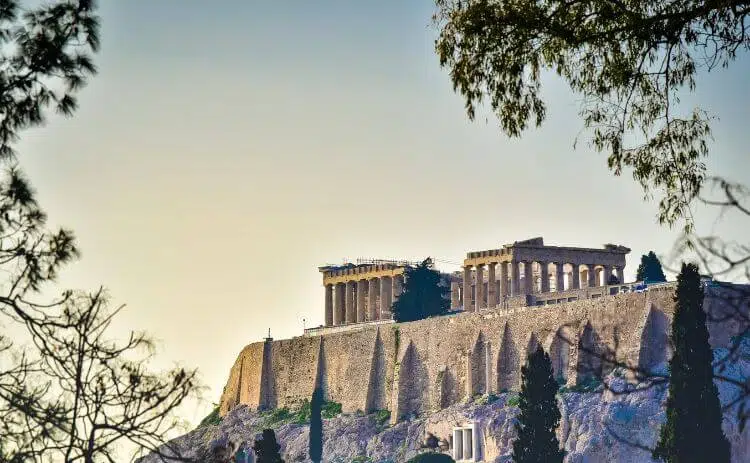
The monuments are some of the most significant ancient buildings remaining in the world, but they also tell the story of the Greek people of Atticus adopting the goddess Athena.
In fact, the monuments on the top of the Acropolis are monuments to Athena, in her different aspects.
That probably sounds a bit dry, but the Acropolis was, according to Greek mythology, the scene of an epic battle between the god of the sea, Poseidon, and Athena, the goddess of love.
The scars and scene of their battle is marked upon the outcrop.
The Acropolis monuments were also a big “we won, you lost” gesture to the Persians. They ushered in the Greek Golden Age.
I can’t think of another site where you can see so many UNESCO World Heritage-listed monuments that is the scene of some of the most important myths in Western history, and which you can see in a couple of hours!
Acropolis main entrance – the most impressive entrance
There are two entrances to the Acropolis. The main entrance takes you on a short path to the formal entrance of the site in Ancient times.
It is located on the western side of the Acropolis and you reach it by walking uphill from the metro or bus station.
You can get to the main entrance by walking about 12 minutes from the Monastiraki metro station.
If you prefer to catch a bus, Number 230 stops at the foot of Acropolis Hill. From here it takes about 6 minutes to reach the entrance.
There is an elevator 350 meters from this main entrance and there are golf carts that can be used to get around the Acropolis for mobility-impaired visitors.

The great thing about entering this way is that you see the site as it was designed to be seen by visitors to mighty Athens during the Classical Era.
But there’s always a downside! The Acropolis is one of the most visited sites in the world – millions of travelers each year trudge up the hill to admire the greatness that was Ancient Athens.
This means the queues can be terribly long.
If you’ve visited other great monuments in Rome, like the Eiffel Tower, for instance, you’ll know what it’s like to stand in the heat waiting to one day go through security!
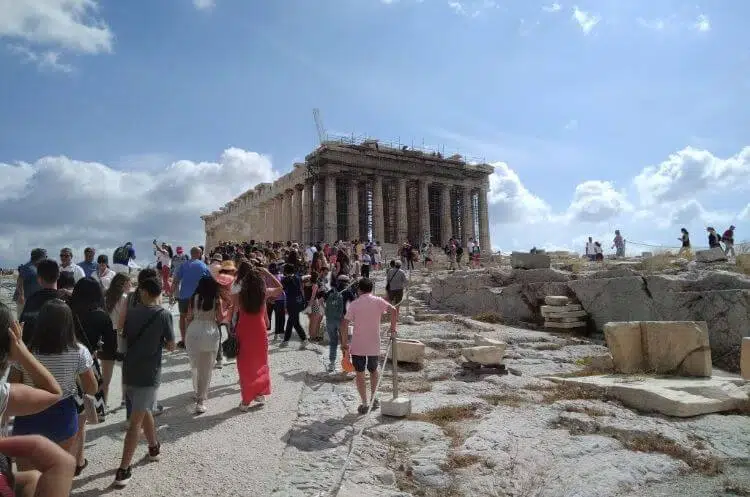
If you are visiting in the middle of summer and after 9.30 am in the morning until about 4 pm, then if you choose to begin your tour of the Acropolis at the main entrance, you will need to wait quite a while to get in, even with a skip-the-line ticket.
There are 6 main sites to see at the Acropolis. If you begin at the main entrance, the order in which you’ll see these marvels are:
3, 4, 5, 6, 2, 1.
Acropolis side entrance – the quickest entrance
In this walking tour, I am starting from the side gate which is way less crowded and is the fastest way to get into the Acropolis.
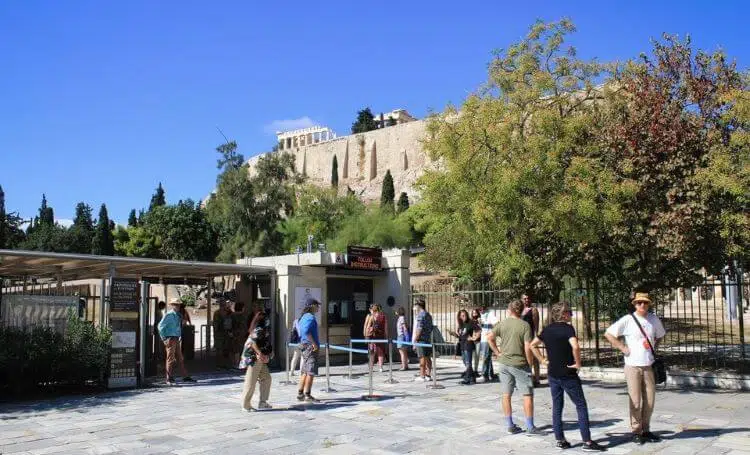
The side entrance is across the pedestrianized road (Dionysiou Areopagitou) from the Acropolis Metro station and the Acropolis Museum. This south entrance leads to the first stop, the Theatre of Dionysus. It is often just called the “Theatre of Dionysus entrance.”
- November 1 to March 31: 8 am to 5 pm (last entry 4.30 pm)
- April 1 to October 31: 8 am to 7 pm (last entry 6.30 pm)
NOTE: As of mid-2023, the Acropolis is closed after midday on days when the temperatures are considered extreme. It sometimes reopens around 5 pm.
To decrease the number of people getting heatstroke in the queues, the number of tickets sold in summer has now been capped.
During the middle of summer, officials pass out water bottles and check on the well-being of people in the very long ticket queues.
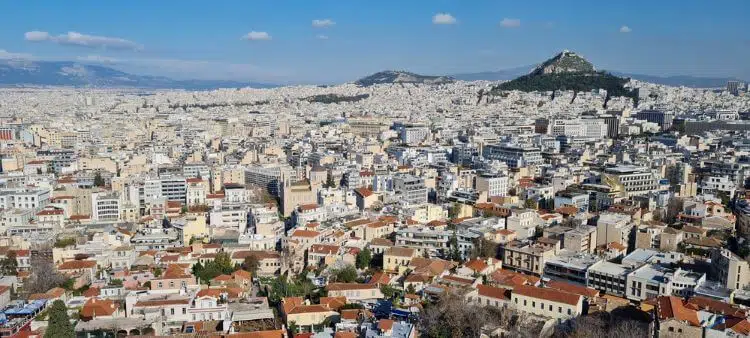
Days when the Acropolis is closed
- New Year’s Day (Jan 1)
- Easter Sunday (Note: this is the Greek Easter Sunday which is NOT the same day as Easter Sunday in most other countries!)
- Christmas Day (Dec 25)
- Boxing Day (Dec 26)
This article may contain compensated links. Please read the disclaimer for more info
You’ve chosen an entrance to the Acropolis and a time to visit, so now you need a ticket that will get you inside the site quickly.
This is a fast and painless process so long as you don’t line up at the main site and hope to get in within a couple of hours!
The other way to get a ticket is to buy an Acropolis skip-the-line ticket online, download it to your phone, and show the electronic ticket when you line up at the ‘pre-purchased tickets’ queue.
Getting admission to the Acropolis in the least time possible is great, but so too is not having to ‘exchange’ your ticket voucher for a ‘real’ ticket.
It’s always the case that you have to trudge a long way back down the slope of the Acropolis to get to the booth where you exchange your online voucher for your ticket!
The best 3 Acropolis admission tickets are electronic skip-the-line priority access tickets with free cancellation up to 24 hours before the start time.
These are booked hundreds of times a day and have thousands of highly positive reviews. I can personally recommend each of these tickets and I have never had the slightest problem with them:
Acropolis online entrance ticket with Audio Guide
Acropolis combo ticket with up to 6 other sites included, acropolis and acropolis museum ticket.
Here is an Acropolis Map that shows you the 6 main points of interest along your route:
Let’s get started! First stop – the place where Theatre was invented – the Theatre of Dionysus.
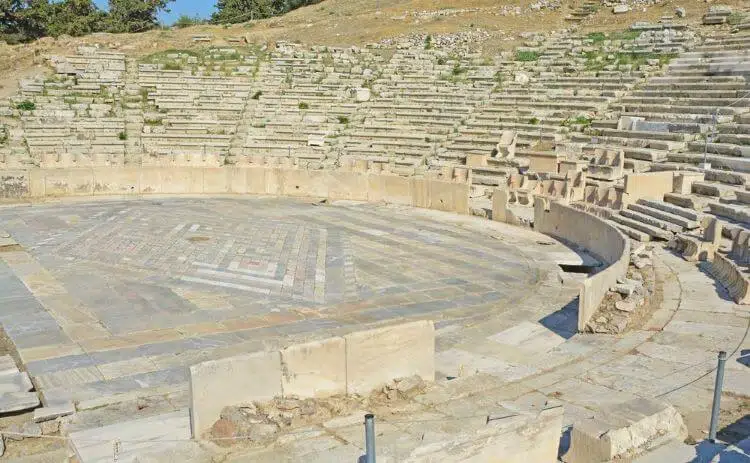
The theatre of Dionysus Eleuthereus was first built as a dirt circle on the western side of the Acropolis.
Audiences sat on the hill and looked down on performances that were originally performed during the festival of Dionysus.
It is the oldest theatre in Greece. It became used after bleachers set up in the Agora for performances collapsed. That’s why the 70th Olympiad celebrations were held here in 499/496 BC.
The orchestra terrace was built in the second half of the sixth century BC and by the 4th century BC, under the Romans, it held 17,000 people.
One of the most impressive parts of the remaining theatre is the marble chairs!
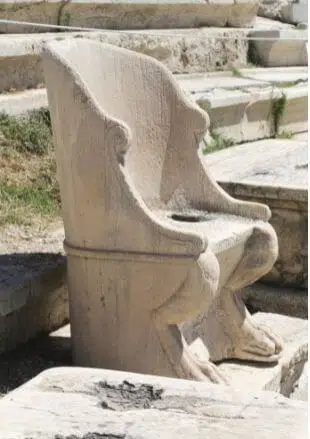
Continuing along the path upwards to the entrance of the Acropolis you come across the impressive Odeon of Herodes Atticus.
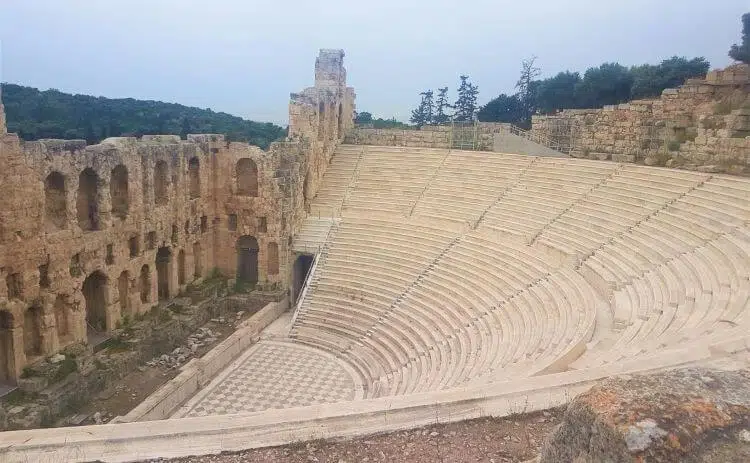
You can probably tell by the name that this is not an ancient Greek structure. Instead, it’s a Roman theatre that was built in 161 AD by Herodes Atticus in memory of his wife.
An odeon has an enclosed roof and until it was sacked by the Heruli in 267 AD, the Odeon of Herodes Atticus had a wooden roof fashioned from Lebanese cedar.
There was once a three-story-high wall enclosing the Odeon.
The structure was restored in 1950 using the same Pentelic marble as was used to construct the Propylaia.
It has since hosted an annual Athens festival and has featured stars such as Maria Callas, Frank Sinatra, Nana Mouskouri, Sting, Elton Jon, Placido Domingo, Luciano Pavarotti, the Foo Fighters, and Florence and the Machine.

The Great Propylaia is a monumental entrance gateway to the religious sanctuaries of Ancient Greece.
There was also sometimes a Lesser Propylaia as well (as at Eleusis, only a few kilometers away in the suburb of Elefsina).
The Propylaia is the entrance to the flat (well, flattish) summit of the Acropolis but don’t bound up the steps and past the columns or you’ll miss two of the best six things on the Acropolis!
This monumental gateway to the Acropolis was copied as a model for other Propylaia (or propylaea) in Greece. The massive outer columns are in the Doric style.
Doric columns are the plainest, thickest, and heaviest of the three classical Greek types of columns. That’s why you’ll most often find them on the outside and lower part of great monuments.
Doric columns have no base, are slightly wider at the bottom, are fluted or grooved, and have a simple slab at the top.
So in summary – they are the biggest ones the ancient Greeks used and when you see them, it means something monumental is being built!

Once past the massive Doric columns, you enter the entrance hall of the Propylaia and you’ll notice that the interior columns are different – these are the more delicate Ionic columns.
They are thinner than the outer Doric columns, and they have a base and a scroll ornament at the top. These columns support the weight of the roof. The roof was made of massive slabs of marble.
Originally there were great gates to the Acropolis that were a further fortification to stop invaders.
None of what you have just walked past was meant to be easy for intruders, and there was once a long ramp to the Propylaia (but now you can take the steps with a handrail!)
Related Myth: The legendary founder of Athens, King Theseus sailed to Crete to slay the Minotaur . Hi father, Aegeus, told him to hoist white sails if he was successful, but otherwise for the ship to sail under black sails.
Unfortunately, Theseus partied a bit too much on the way home and forgot to change the sails to white. When Aegeus saw the ship returning with black sails from the Propylaia, he threw himself off the Propylaia to his death!
When you reach the top of the steps of the Propylaia and turn to look out towards Athens, you’ll notice a very small temple on your left, jutting out from the Propylaia.
This is the Temple of Athena Nike.

Nike is the winged goddess of Victory and is an aspect of the goddess Athena.
This fusion of the two goddesses into one is displayed in the Temple of Athena Nike which warns foreigners to Athens that they are protected by a powerful and victorious goddess.
It was built in 402 BC using only Ionic columns which was a big deal back then and considered a huge architectural innovation. There was once a great winged statue of Athena Nike here.
Around the parapet were slabs of Pentelic marble about a meter high on which there were friezes.
There is a slab from the southern parapet in the Acropolis Museum that shows the goddess Athena unbinding her sandal before entering the Temple of Nike.

The Parthenon is the most important surviving building of Classical Greece and one of the world’s most important cultural monuments and for this reason alone, it is worth trekking up to the top of the Acropolis.
It is one of Pericles’ monumental constructions to celebrate the victory over the Persians.
This magnificent monument was a Temple to Athena. An earlier Pre-Parthenon was demolished to make way for the new building which was originally a Treasury.
The Parthenon was built from 437 BC to 436 BC but it has had a terrible history of destruction and it’s a wonder it is still standing at all.
The Parthenon once held a colossal statue of Athena but over the centuries was converted into a Christian church and an Ottoman mosque.
In 1687 the Venetians fired upon the Parthenon, exploding an Ottoman stockpile of ammunition. This explosion did enormous damage.
In 1800-1803 Lord Elgin then removed some of the remaining sculptures which have infamously become known as the Elgin Marbles.
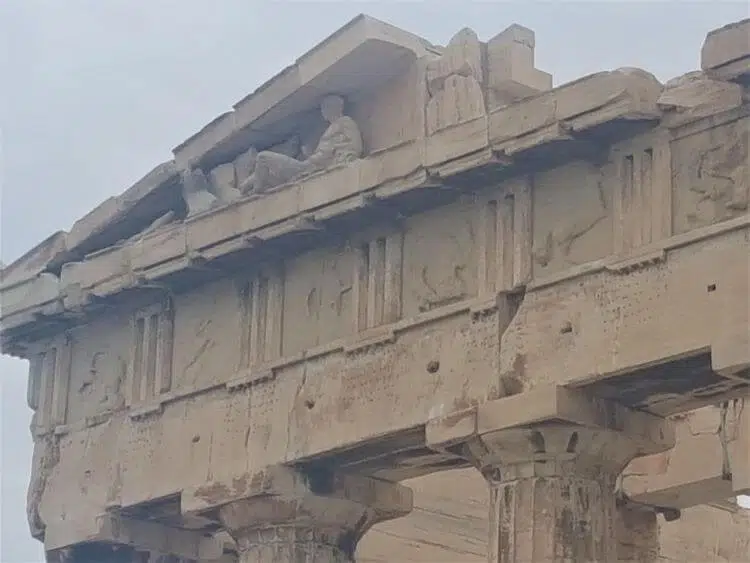
There are some wonderful decorative sculptures remaining on the Parthenon and they’re considered highlights of Greek Art.
This building symbolizes Western democracy and civilization and is surely a triumph of Ancient Greek civilization.
You will likely see scaffolding and other structures for protecting and renovating the ancient structure on your visit. Make sure to check out the Acropolis Museum for more treasures from the Parthenon.
Like the Temple of Nike and the Odeo of Herodes Atticus, you can’t go inside the Parthenon but you can see the remaining sculptures (apart from the Elgin marbles) at the Acropolis Museum.
When I first visited the Acropolis, I was so excited to see the Parthenon, I didn’t give much attention to the Erectheion but that was a mistake!
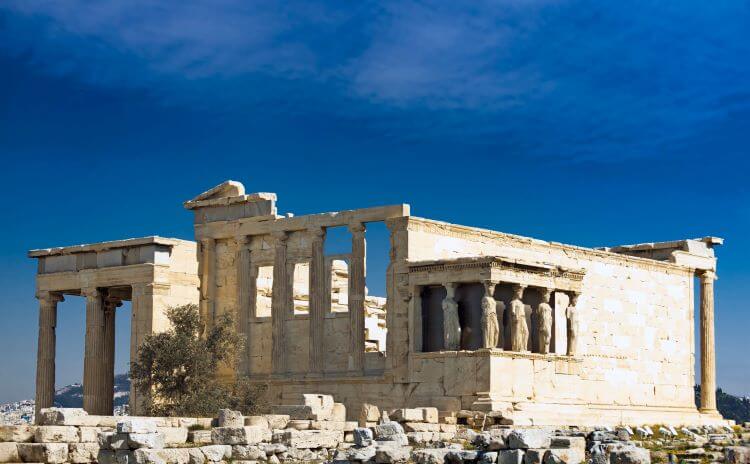
This building bears the scars of the battle of the gods for the hearts of the Athenians.
There’s a hole in the roof of Erechtheion where, according to the legend, Poseidon’s trident was thrown from the sky to the earth.
The place where it hit the ground is a small well believed to spring salt water. You can see both of these places at the Erechtheion.
To the side of the Erechtheion – the side that faces the Propylaea – you’ll find the legendary olive tree that Athena created when the people of Athens chose her to be their goddess instead of Poseidon.
The building also has a ‘porch’ known as the Porch of the Caryatids.
A caryatid is a sculpture of a female that acts instead of a pillar or column, holding up a building. There is a piece of marble atop the heads of the figures called an entablature.

The caryatids on the porch of the Caryatids on the Erechtheion are, unfortunately, replicas. BUT you can see 5 of the six caryatids at the Acropolis Museum (see the section below).
The sixth caryatid can be seen in the British Museum – it was taken from the Acropolis by Lord Elgin early in the 19th century.
Caryatids were beautiful girls from the village of Caryae that became part of the town of Sparta. Their strength was said to be as great as their beauty.
They became associated with the cult of Athena and it is thought that is why they appear on the Erechtheion.
The caryatids on the Erechtheion porch are the most famous of the caryatids but there were also such female columns in ancient Delphi and even in Phoenicia.
So there you have it – the essential theatres, odeums, gates, monuments, and temples of the Acropolis of Athens!
If you are headed down to the Acropolis Museum, then retrace your steps past the Theatre of Dionysus. On leaving the site, head across Dionysiou Areopagitou Street to the Museum at No. 15.
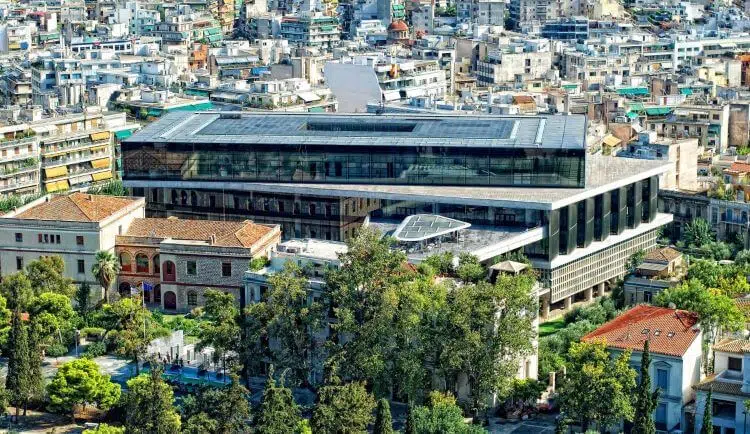
I strongly suggest that after you visit the Acropolis, you visit the New Acropolis Museum which is dedicated to the Parthenon.
The “real” pieces that you see from the Parthenon and the Erechtheion are here. It is a spectacular building and provides a truly world-class museum experience.
A combined skip-the-line electronic Acropolis and Acropolis Museum ticket is better value than buying them separately, and much better than queueing to get into the Museum when you’ve just walked down from the Acropolis!
If you’d like to read a more detailed article about what to bring and specific tips to help make your day at the Acropolis a truly memorable one, check out Everything You Need to Know About Visiting the Acropolis – Acropolis Entrance Fees, Hours, and Tours.
If you’d like to stay in one of the areas where the hotels have spectacular views of the Acropolis lit up at night, check out Best Athens Hotels Near The Acropolis.
If you’d rather listen than read – you’ll enjoy my podcast interview with a professional myth storyteller about the Acropolis.

Ultimate Self-Guided Athens Walking Tour
Last Updated: March 4, 2024
Athens is a bustling metropolis – about half of Greece lives in the city. This means that there is always something to see and new parts of the city to discover. Of course, it also means there are countless places to eat and drink. Come along with us on this self-guided Athens walking tour, which includes some of our favorite traditional and contemporary Greek snacks, as well as panoramic views of this sprawling city.
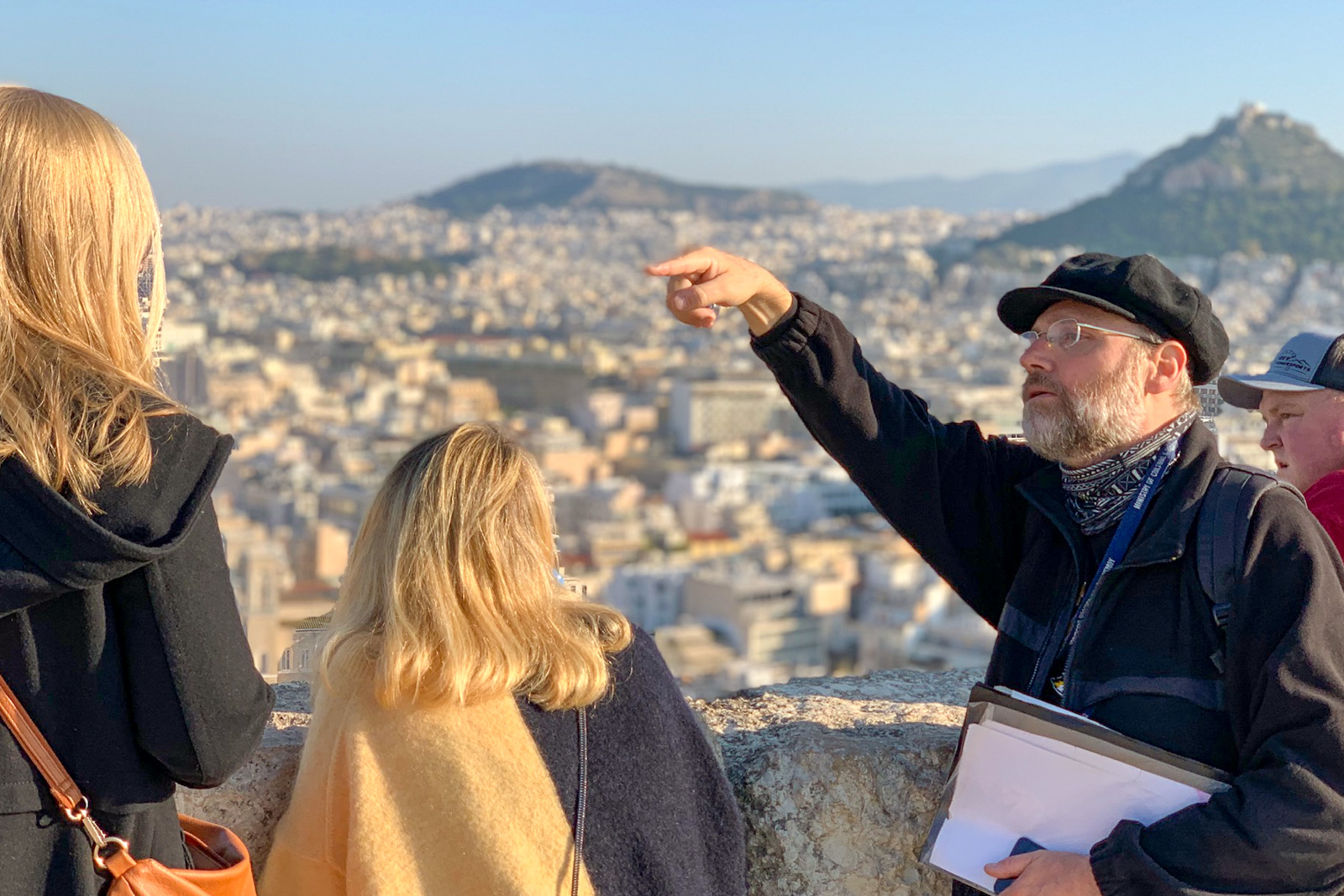
Table of Contents
Monastiraki Square
Start your day in Monastiraki Square, the very center of Athens. The metro station has stops on both the Green and Blue lines making it easy to get to. Standing in the middle of Monastiraki you have a view that stretches over a Greek church, an old Mosque, an ancient Roman library, and up to the ancient Greek Parthenon– so many layers of Athenian history.
If you walk down Aiolou Street with the Acropolis behind you, you will find, Krinos, one of our favorite donut shops. Going strong for 100 years, this sweet shop has been running since 1923. They are famous for their loukoumades – Mediterranean fried pastries similar to donuts.
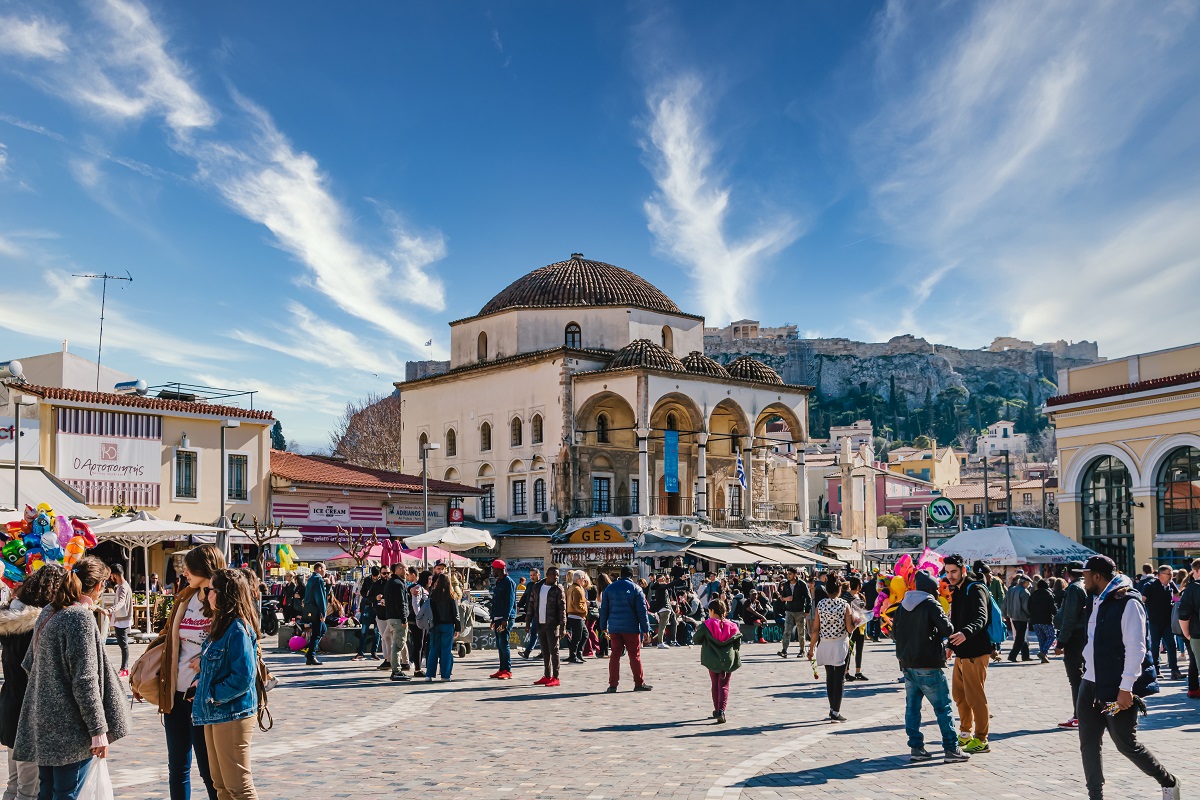
Krinos: Traditional Greek donuts
There’s nothing like a bit of sugar to kick-start your day, and there’re no better sweets than loukoumades , traditional Greek donuts. Krinos makes some of the best loukoumades in Athens, served slathered with honey or chocolate. Entering Krinos is a bit like stepping back in time – all of the decor looks untouched for decades, and the sweets are still served on little metal cafeteria trays. We recommend a stiff Greek coffee to go along with the sugary bites.

Varvakios: The market with a little bit of everything
No Athens walking tour would be complete without a visit to a market. Leaving Krinos, head west towards Athinas street and you will find yourself in the middle of the Central Athens Varvakios Market. This open-air market sells spices, cheeses, olives, meat, fish, flowers, glassware, carpets, and more. Meander through the stalls see the different wares but make sure you get some Greek oregano and olives as a souvenir. The olive sellers usually have a little machine that can even vacuum seal the olive bag, making it perfectly travel-ready.

Rex Theater and the Academy of Athens
When you weave your way outside of the market, keep going down Athinas street, and you will soon arrive in the Omonia neighborhood. Stroll around the massive fountain, take a selfie if you’re feeling inspired, and head to your right down Panepistimiou street. If you keep walking you will pass the historical Rex Theater , considered Athen’s first skyscraper. Soon after, you’ll reach the Academy of Athens– the national university building where students study history, law, and literature in a neoclassical building erected in the 1800s.
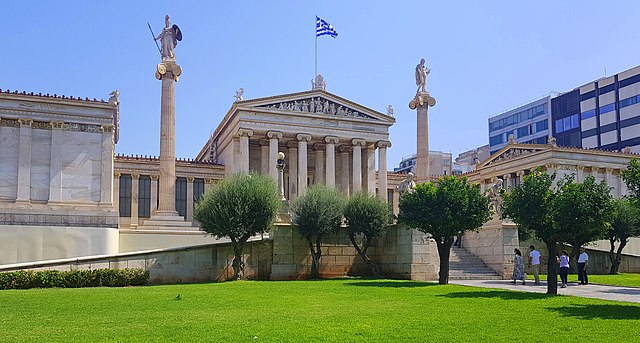
Kora Bakery: Innovative and classic sandwiches
After you pass the Academy, head to your left uphill until you reach Kora bakery. This new venture was opened by two bakers who wanted to make simple, quality bread while also focusing on supporting charities and minimizing their carbon footprint. Known for their hand-crafted sourdough, Kora also has delectable croissants made with French butter, and savory sandwiches stuffed with local vegetables. Our favorite is the mortadella sandwich, served on thick hand-made focaccia.

Insider’s tip: Have limited time? Discover our top picks for what to do during two days in Athens .
National Gardens and Zappeion Hall
Continue strolling down Solonos street and you will reach the National Gardens. The paths in this park loop and wind into each other and if you let your feet lead you, you will happen upon botanical gardens, a mini zoo, the colonnaded Zappeion Hall , an outdoor theater, playgrounds and various cafes–perfect for an afternoon coffee if you’re so inclined. Athenians gather in the gardens for fresh air, especially on sunny days, and there’s a good chance you’ll stumble on a band playing live music amongst the trees.
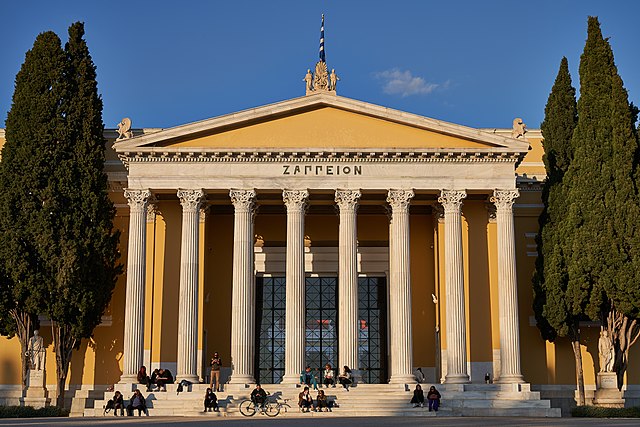
Syntagma: Square of the Constitution
Exit the gardens through the main gateway and you will arrive right on central Syntagma square. Syntagma means constitution in Greek, and is home to the parliament and much of the political life of the city. Take a stop in the middle of the square for some of the best people-watching in the city.
From Syntagma, walk down Ermou street, the shopping center of Athens. If you are in need of high-quality shoes or all-natural Greek beauty products, look no further.
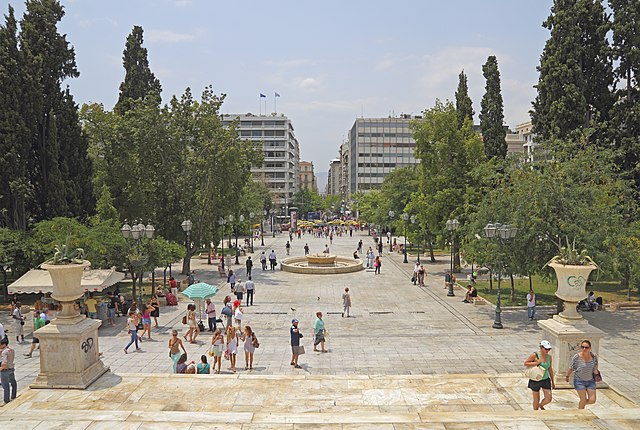
Meze break: small-plate snacks
When you hit Fokionos street, hang a left. You will have to wind your way down some tiny streets, bustling with people and motorbikes until you reach To Kafenio , a traditional Greek meze restaurant, which serves small plates of all sorts of Greek classics like rice-stuffed dolmades , the fried cheese saganaki , and flame-roasted aubergine salad.
According to the owners, the building of To Kafenio is at least 400 years old and the restaurant is decorated like a village taverna, made to make you feel right at home. Make sure you take your time with your afternoon meze , and if you want the full experience order a small bottle of Greek ouzo to help your digestion before you begin your walk again!
Roman Agora and Hadrian’s Library
When you do get moving, keep the Acropolis on your left and walk until you reach the ancient Roman Agora and the remains of Adrian’s Aqueduct. Turn so the Acropolis is behind you, and curl your head downwards until you see Hadrian’s Library– once the largest research institution in ancient Greece. This is one of Athens’ most impressive Roman ruins. Keep walking and you will find yourself again in central Monastiraki Square.
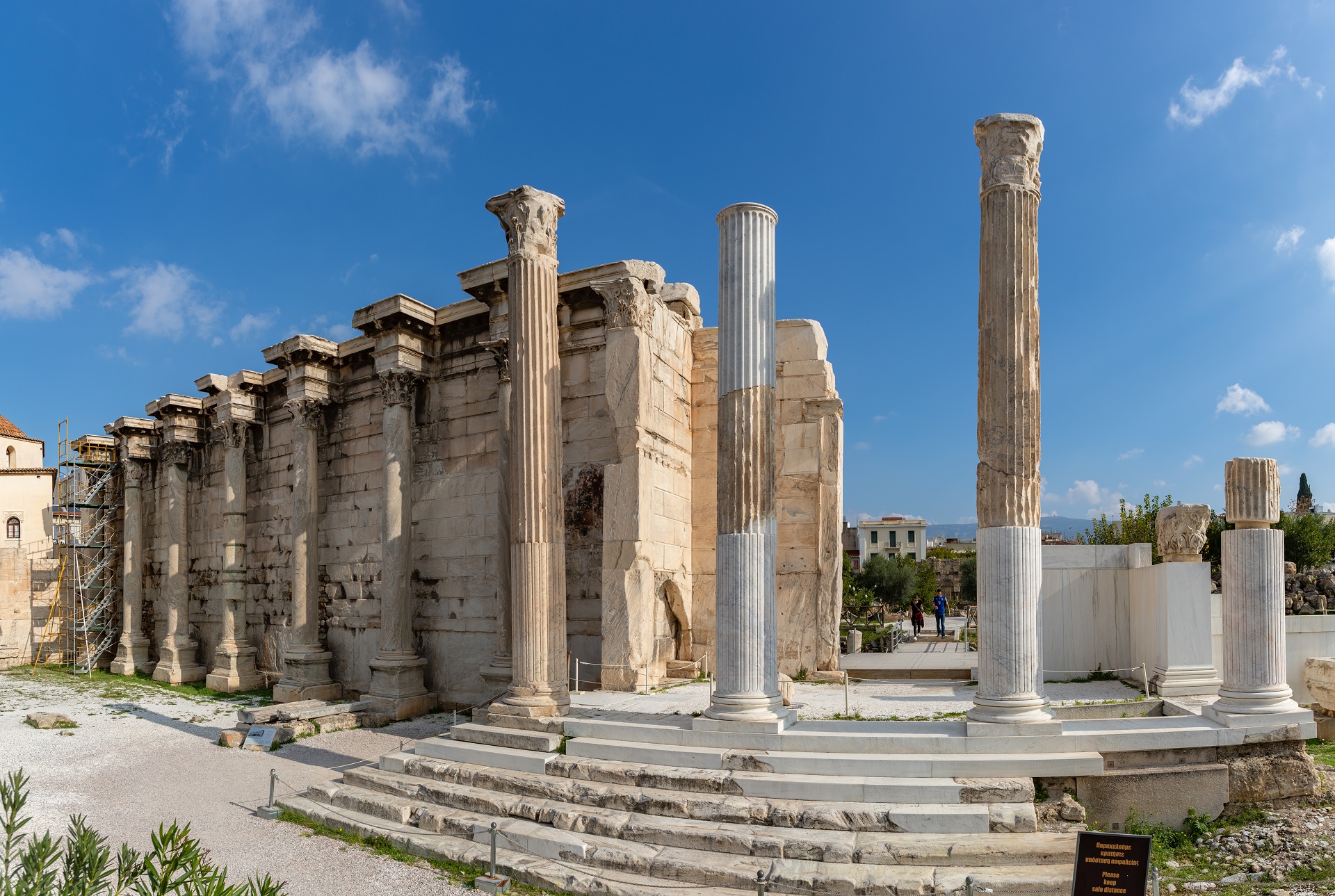
Cocktails and a panoramic view
As you finish your day in Monastiraki there’s no better way to cap off all the adventure than with a flavorful cocktail. 360 Cocktail Bar has a verdant rooftop that makes you feel like you could reach out and touch the Acropolis, and it gives you a bird-eye view of the whole tour you just made. Not to mention the bar has a host of specialty cocktails named after the different Greek islands, made with ingredients local to each one.
If you’re feeling energized, Monastiraki has many more bars to offer whatever piques your fancy –live music, avant-garde art vibes, or local beers. Or you can call it a day and rest up for another Athens walking tour in a different part of the city.

Experience the best of Athens in a single day on our Athens In a Day Walking Tour! Experience Athens’ main attractions, including the Acropolis and Greek Agora, ancient and modern, with skip-the-line tickets and a local guide, topped off with a traditional Greek lunch, all in one comprehensive walking tour.

About the author
Cora is a Greek-American travel writer from Ohio, USA. Though born and raised in the United States, her roots trace back to Greece and Cyprus through her parents. While she now calls Spain her home and workplace, she frequently visits her family back in Greece, immersing herself in the richness of Greek gastronomy and culture.
More by Cora C.
Subscribe to our Newsletter
Sign up to get curated travel tips, inspiration, and travel deals by joining our community of Walkers.

IMAGES
VIDEO
COMMENTS
Stop 4: The Temple of Athena Nike. When you reach the top of the steps of the Propylaia and turn to look out towards Athens, you’ll notice a very small temple on your left, jutting out from the Propylaia. This is the Temple of Athena Nike. Nike is the winged goddess of Victory and is an aspect of the goddess Athena.
Explore the history, culture, and cuisine of Athens with this self-guided walking tour. Start in Monastiraki Square and end with a panoramic view of the city, stopping at landmarks, markets, bakeries, and more along the way.